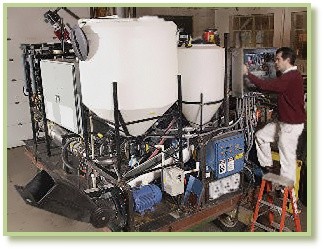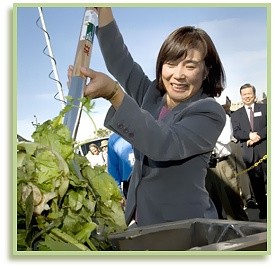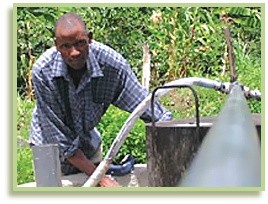Waste is one of the major environmental issues for every country. If more and more people around the world subscribe to the Reduce, Reuse, and Recycle way of life, a lot less waste will be produced. Better still, if we could somehow turn all the waste produced into clean energy and some other reusable products, not only will landfills be a thing of the past, it will go a long way in reducing greenhouse gases emissions.
Various environmentally friendly developments and projects initiated around the world clearly demonstrate that sustainable development and averting the climate change crisis are very achievable goals.
First Bio-Methanization Plant in Singapore
In Golden Year 2 (Year 2005), a major organic waste treatment plant was built in Singapore by waste remediation company IUT. This plant specializes in converting food and other organic waste from hotels, kitchens and food factories into clean energy and compost. It utilizes bio-methanization process where bacteria break down food waste into compost and methane gas. The gas is captured and used to fuel large gas engines to generate electricity. It is the first in Singapore and the largest of its kind in Asia. The plant has a capacity of processing up to 800 tons of organic waste per day and is able to generate enough electricity for its own operation and over 10,000 other industrial facilities.
Many other countries also have similar developments or help farmers and manufacturers to have waste conversion facilities on their own properties so that the energy generated would be less expensive and could be quickly made available.
Reference: http://www.iutglobal.com/iut-tech-bio-methanisation.asp
Portable Generator That Turns Trash Into Electricity
 |
Professor Nathan Mosier of the Purdue University works with the tactical biorefinery designed to convert waste into electricity |
Scientists from Purdue University have created a portable bio-refinery, the size of a small moving van, which efficiently converts food, paper and plastic trash into electricity.
The bio-refinery processes different kinds of waste at the same time. It ferments food waste into ethanol using industrial yeast and turns plastics, paper, and other residual waste into methane and low-grade propane using a gasification unit. The gas and ethanol are then combusted in a diesel engine that powers a generator to produce electricity. The system is highly efficient, able to produce about 90% more energy than it consumes, with the main by-product being a benign ash.
Although it has been developed for military use, its creators hope that it will soon be practical to use in civilian settings, such as in disaster-relief zones or as a supplementary power system.
Reference: http://www.technologyreview.com/Energy/18183/
Converting Biomass and Food Waste into Usable Energy
UC Davis Professor
Ruihong Zhang shovels fresh table scraps from San Francisco restaurants
into the biogas energy converter. |
 |
Professor Ruihong Zhang at the University of California Davis campus has developed an anaerobic digester that uses bacteria to convert food waste, crop residue and other biomass into hydrogen and methane gases, which can be burned to produce electricity or used as fuel for vehicles.
The Biogas Energy Project initiated by the university is touted as the first large-scale demonstration of this new technology in the United States. Each ton of food waste can possibly produce enough energy to provide electricity to power 10 average Californian homes for one day.
Professor Zhang’s system differs from other anaerobic digesters that are mainly used at municipal wastewater treatment plants and livestock farms in three key aspects. It processes a wider variety of solid and liquid wastes, including food scraps, yard trimmings, animal manure and rice straw. Compared to other digesters, it has higher efficiency, requiring only half the time to turn waste into energy. Furthermore, it produces two clean energy gases - hydrogen and methane, while other digesters produce only methane.
Reference: http://www.news.ucdavis.edu/search/news_detail.lasso?id=7915
Making Power from Acid Water
Farmer Moses Urio hopes
he will no longer have to buy diesel |
 |
In Tanzania, a new bio-gas converter was developed as a part of a larger project funded by the Swiss government to boost the incomes of coffee farmers.
The converter recycles the waste water from the processing of raw coffee beans, which are high in acid; this is the acid that micro-organisms like to feed on. The by-product of the feeding process is methane gas, which can be used instead of diesel to power farmers’ machines.
The bio-gas converter will not only help farmers to make more money from their coffee but also prevent the high acidic water causing severe environmental damage.
Reference: http://news.bbc.co.uk/2/hi/africa/6571547.stm
Using Bacteria to Extract Hydrogen from Chocolate Waste
The British research team, led by Lynne Mackaskie at the University of Birmingham, Central England, found that Escherichia coli bacteria, when fed with waste products from a chocolate factory, produce hydrogen, one of the cleanest renewable fuels. This discovery of extracting hydrogen from food waste could be a real breakthrough for both industry and the environment because the process works well on many other types of waste, not limited to chocolate waste.
Reference: http://environment.about.com/od/renewableenergy/a/chocolatefuel.htm
Turning Food Waste into Cooking Gas
A national laboratory in the Philippines
has developed an environmentally-friendly portable biogas digester that
converts kitchen waste into usable gas via a natural fermentation process.
It can store more than 211 liters of biodegradable kitchen waste. The
fermentation process takes overnight and the gas produced may be good
for a day’s cooking. ![]()
Reference: http://www.ebc.org.ph/
|
||||||